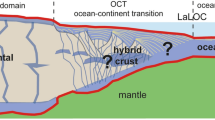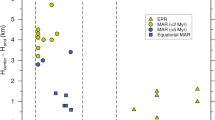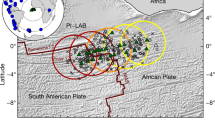Abstract
A variety of observations indicate that mid-ocean ridges produce less crust at spreading rates below 20 mm yr-1 (refs 1–3), reflecting changes in fundamental ridge processes with decreasing spreading rate. The nature of these changes, however, remains uncertain, with end-member explanations being decreasing shallow melting3 or incomplete melt extraction2, each due to the influence of a thicker thermal lid. Here we present results of a seismic refraction experiment designed to study mid-ocean ridge processes by imaging residual mantle structure. Our results reveal an abrupt lateral change in bulk mantle seismic properties associated with a change from slow to ultraslow palaeo-spreading rate. Changes in mantle velocity gradient, basement topography and crustal thickness all correlate with this spreading-rate change. These observations can be explained by variations in melt extraction at the ridge, with a gabbroic phase preferentially retained in the mantle at slower spreading rates. The estimated volume of retained melt balances the ∼1.5-km difference in crustal thickness, suggesting that changes in spreading rate affect melt-extraction processes rather than total melting.
This is a preview of subscription content, access via your institution
Access options
Subscribe to this journal
Receive 51 print issues and online access
$199.00 per year
only $3.90 per issue
Buy this article
- Purchase on Springer Link
- Instant access to full article PDF
Prices may be subject to local taxes which are calculated during checkout




Similar content being viewed by others
References
Chen, Y. J. Oceanic crustal thickness versus spreading rate. Geophys. Res. Lett. 19, 753–756 (1992)
Cannat, M. How thick is the magmatic crust at slow spreading oceanic ridges? J. Geophys. Res. 101, 2847–2857 (1996)
White, R. S., Minshull, T. A., Bickle, M. J. & Robinson, C. J. Melt generation at very slow-spreading oceanic ridges: Constraints from geochemical and geophysical data. J. Petrol. 42, 1171–1196 (2001)
Langmuir, C. H., Klein, E. M. & Plank, T. in Mantle Flow and Melt Generation at Mid-Ocean Ridges (eds Morgan, J. P., Blackman, D. K. & Sinton, J. M.) 183–281 (Geophysical Monograph 71, American Geophysical Union, Washington DC, 1993)
Blackman, D. K. & Kendall, J.-M. Seismic anisotropy in the upper mantle. 2. Predictions for current plate boundary flow models. Geochem. Geophys. Geosyst. 3, doi:10.1029/ 2001GC000247 (2002)
Müller, R. D., Walter, W. R., Royer, J.-Y., Gahagan, L. M. & Sclater, J. G. Digital isochrones of the world's ocean floor. J. Geophys. Res. 102, 3211–3214 (1997)
Purdy, G. M. The seismic structure of 140 Myr old crust in the western central Atlantic Ocean. Geophys. J. R. Astron. Soc. 72, 115–137 (1983)
Gaherty, J. B., Lizarralde, D., Collins, J. A., Hirth, G. & Kim, S. D. Mantle deformation during slow seafloor spreading constrained by observations of seismic anisotropy in the western Atlantic. Earth Planet. Sci. Lett. (in the press)
Ben Ismail, W. & Mainprice, D. An olivine fabric database: an overview of upper mantle fabrics and seismic anisotropy. Tectonophysics 296, 145–157 (1998)
Jordan, T. H. in The Mantle Sample: Inclusions in Kimberlites and Other Volcanics (eds Boyd, F. R. & Meyer, H. O. A.) 1–14 (American Geophysical Union, Washington DC, 1979)
Stephen, R. A. Seismic anisotropy in the upper oceanic crust. J. Geophys. Res. 90, 11383–11396 (1985)
Detrick, R. S., Toomey, D. R. & Collins, J. A. Three-dimensional upper crustal heterogeneity and anisotropy around Hole 504B from seismic tomography. J. Geophys. Res. 103, 30485–30504 (1998)
Spiegelman, M. & Reynolds, J. R. Combined dynamic and geochemical evidence for convergent melt flow beneath the East Pacific Rise. Nature 402, 282–285 (1999)
Grove, T. L., Kinzler, R. J. & Bryan, W. B. in Mantle Flow and Melt Generation at Mid-Ocean Ridges (eds Morgan, J. P., Blackman, D. K. & Sinton, J. M.) 281–310 (Geophysical Monograph 71, American Geophysical Union, Washington DC, 1993)
Dick, H. J. B. in Magmatism in the Ocean Basins (eds Sounders, A. D. & Norry, M. J.) 71–105 (Geol. Soc. Spec. Publ. No. 42, Bath, 1989)
Kelemen, P. B., Kikawa, E., Miller, D. J. & The Leg 209 Scientific Party. ODP Leg 209 drills into mantle peridotite along the mid-Atlantic ridge from 14°N to 16°N. JOIDES J. 30, 14–19 (2004)
Jokat, W. et al. Geophysical evidence for reduced melt production on the Arctic ultraslow Gakkel mid-ocean ridge. Nature 423, 962–965 (2003)
Green, D. H. & Ringwood, A. E. An experimental investigation of gabbro to eclogite transformation and its petrological applications. Geochim. Cosmochim. Acta 31, 767–833 (1967)
LADLE Study Group. A lithospheric seismic refraction profile in the western North Atlantic Ocean. Geophys. J. R. Astron. Soc. 75, 23–69 (1983)
Asada, T. & Shimimura, H. Long-range refraction experiments in deep ocean. Tectonophysics 56, 67–82 (1979)
Zverev, S. M. & Yaroshevskay, G. A. in Composition, Structure, and Dynamics of Lithosphere-Asthenosphere System (eds Fuchs, K. & Froidevaux, C.) 273–290 (Geodyn. Ser. 16, American Geophysical Union, 1987)
Goodman, D. & Bibee, L. D. Measurements and modelling of possible mantle constituents from a long-line seismic refraction experiment in the West Philippine Basin. Geophys. J. Int. 106, 667–675 (1991)
Chian, D., Hall, J. & Marillier, F. Lithospheric wide-angle seismic profiles using stacked airgun shots. Geophys. Res. Lett. 23, 2077–2080 (1996)
Lizarralde, D. & Holbrook, W. S. US mid-Atlantic margin structure and early thermal evolution. J. Geophys. Res. 102, 22855–22875 (1997)
Nakamura, Y., Donoho, P. L., Roper, P. H. & McPherson, P. M. Large-offset seismic surveying using ocean-bottom seismographs and air guns: Instrumentation and field technique. Geophysics 52, 1601–1611 (1987)
Zelt, C. A. & Smith, R. B. Seismic traveltime inversion for 2-D crustal velocity structure. Geophys. J. Int. 108, 16–34 (1992)
Grow, J. A. & Markl, R. G. IPOD-USGS multichannel seismic reflection profile from Cape Hatteras to the Mid-Atlantic ridge. Geology 5, 625–630 (1977)
Christensen, N. I. Compressional wave velocities in possible mantle rocks to pressures of 30 kilobars. J. Geophys. Res. 79, 407–412 (1974)
Greenfield, R. J. & Graham, E. K. Application of a simple relation for describing wave velocity as a function of pressure in rocks containing microcracks. J. Geophys. Res. 101, 5643–5652 (1996)
Goes, S. & Govers, R. Shallow mantle temperatures under Europe from P and S wave tomography. J. Geophys. Res. 105, 11153–11169 (2000)
Acknowledgements
We thank the Lamont Marine Office and the captain and crew of the RV Maurice Ewing for their efforts during cruise EW-0106. The efforts of J. DiBernardo, J. Stennet and J. Diebold are appreciated. This work was supported by the US National Science Foundation.
Author information
Authors and Affiliations
Corresponding author
Ethics declarations
Competing interests
The authors declare that they have no competing financial interests.
Supplementary information
Supplementary Figures 1 - 11
Fig 1: Gravity model, seismically constrained crust. Fig 2: Gravity model, isostatically balanced crust. Fig 3: Gravity model, retained melt to 30-km depth. Fig 4: Gravity model, retained melt to 60-km depth. Fig 5: Summary of gravity modeling results. Fig 6: Melt extraction/retention cartoon. Fig 7: Amplitude analysis for FAIM profile Tecate. Fig 8: Portion of FAIM profile 420. Fig 9: Portion of FAIM profile cass. Fig 10: Portion of FAIM profile Tecate. Fig 11: Model parameters and fit statistics for the crustal thickness measurements. (PDF 4258 kb)
Supplementary Information
a) Descriptions of crustal-thickness averages, FAIM Line 1 gravity profile and modeling, and a conceptual model for melt retention. b) Supplemental figure captions, Figures S1-S10. (DOC 36 kb)
Rights and permissions
About this article
Cite this article
Lizarralde, D., Gaherty, J., Collins, J. et al. Spreading-rate dependence of melt extraction at mid-ocean ridges from mantle seismic refraction data. Nature 432, 744–747 (2004). https://doi.org/10.1038/nature03140
Received:
Accepted:
Issue Date:
DOI: https://doi.org/10.1038/nature03140
This article is cited by
-
Deep hydration and lithospheric thinning at oceanic transform plate boundaries
Nature Geoscience (2022)
-
Episodic magmatism and serpentinized mantle exhumation at an ultraslow-spreading centre
Nature Geoscience (2018)
-
Rapid transition from continental breakup to igneous oceanic crust in the South China Sea
Nature Geoscience (2018)
-
Variations in melting dynamics and mantle compositions along the Eastern Volcanic Zone of the Gakkel Ridge: insights from olivine-hosted melt inclusions
Contributions to Mineralogy and Petrology (2014)
Comments
By submitting a comment you agree to abide by our Terms and Community Guidelines. If you find something abusive or that does not comply with our terms or guidelines please flag it as inappropriate.



